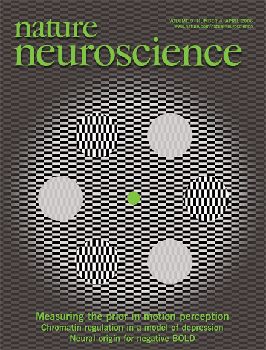 |
Noise characteristics and prior expectations in human visual speed perceptionAlan A Stocker and Eero P Simoncelli Nature Neuroscience 9(4), p. 578-585advanced online publication, 19 march 2006, doi:10.1038/nn1669 cover: a bayesian model of human motion perception combines a prior expectancy for low speeds with noisy sensory information. low contrast stimuli provide a weaker and thus less reliable sensory signal, so the prior contributes more to perception. fixating on the central point of this cover image elicits a stronger illusion of motion in the surrounding apertures with high contrast. |
Human visual speed perception is qualitatively consistent with a Bayesian observer that optimally combines noisy measurements with a prior preference for lower speeds. Quantitative validation of this model, however, is difficult because the precise noise characteristics and prior expectations are unknown. Here, we present an augmented observer model that accounts for the variability of subjective responses in a speed discrimination task. This allowed us to infer the shape of the prior probability as well as the internal noise characteristics directly from psychophysical data. For all subjects, we found that the fitted model provides an accurate account of the data across a wide range of stimulus parameters. The inferred prior distribution shows significantly heavier tails than a Gaussian, and the amplitude of the internal noise is approximately proportional to stimulus speed, and depends inversely on stimulus contrast. The framework is general, and should prove applicable to other experiments and perceptual modalities.
reprint (pdf)
supplementary material (online)
cover
reprint, including cover and supplementary material (4.5mb)
see also:
- Faculty1000 evaluation
- News and Views comment by Matteo Carandini, Nature Neuroscience vol 9(4) p.468-470
- scienceNOW: flash report about this article in the online news section of 'Science' magazine